The first fish you ever owned was probably a bright-colored guppy. Guppies are absolute staples in an aquarium. But do you know whether your guppies were male or female?
Guppies thrive in the tropical waters of South America. Their unique markings make them beautiful to watch, but their colors aren’t the only signs of whether your guppy is a male or female. Serious aquarists know you can better manage your aquarium, control breeding, and breed healthier fish when you can tell the boy and girl guppies apart.
Table of Contents
8 Essential Differences Between Male and Female Guppies
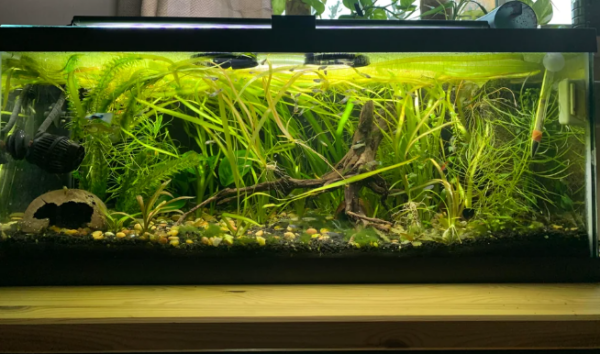
When you know what signs to look for, you can easily tell whether your guppy is a boy or a girl “gup.” It’s not like they wear a sign to advertise they’re girls or boys, but when you know what their unique gender characteristics are, you’ll soon tell them apart.
Here are the main tell-tale signs to know what gender your guppy is:
1. Spotted and Splotched Fins
Male and female guppies don’t have similar fin structures, but perhaps the most obvious difference is that male guppies have spotted or splotched fins. Female guppies have plain-colored fins that are usually pale or silvery.
If you love color variety, then a male guppy is your choice, as they often have a wide range of colored fins, many with stripes, spots, and colored patches. These male guppies put on a stunning display (especially during mating season).
Female guppies are paler in color, and while their fins may have more color, you’ll usually find their bodies are silver, white, and cream, and their colors fade when pregnant.
2. Overall Size of the Fish
Another rather noticeable difference between the fish sexes is their size once mature. Male guppies are smaller than females at 0.6 to 1.4 inches maximum size, while females can reach a length of 1.2 to 2.4 inches when mature.
It can be a little harder to tell them apart when the fish are still young and more similar in length. The size difference is so the female guppy can develop eggs (and then fries) inside her body during breeding time.
3. Body Shape
As you can imagine, female guppies are often more rounded when mature as they develop extra padding and spacing for eggs to develop before the spawning period. The male guppy remains leaner and has a more slender build.
A pregnant guppy female will have a boxy shape and develop an almost square belly with the pressure of all those fertilized eggs inside her. Once the eggs mature inside her, she’ll give birth to live fries. Your female guppy may carry as many as 30 fries inside her when pregnant, which contributes to her sudden size increase.
4. Tail Shape
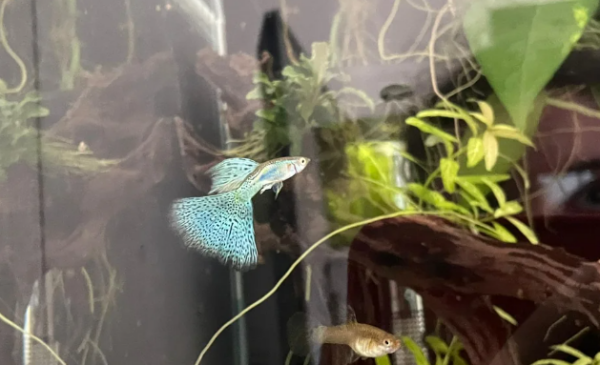
While guppies have similarly shaped fins, their tail fins differ considerably between the sexes. Male guppies have heavy, long tails that are more fleshy and flashy. Often, a range of colors are on parade on their lush tail fins.
In contrast, the female’s tail fin is functional, much shorter, and not nearly as colorful. Female guppies often have a pale, almost stubby tail.
Male guppies can be classified according to the shape of their tail, while the female guppy has a standard short rounded or flag-shaped tail. Among the male guppies, you’ll find a range of tail fin shapes, including:
- Flag tail
- Veil tail
- Fantail
- Delta tail
- Lyre tail
- Double swordtail
- Top or bottom swordtail
- Pintail
- Spear tail
- Pointed tail
- Spade tail
5. Fin Shape
Another dead giveaway of whether your guppy is a boy or a girl is their fin shape. Female guppies, being focused on motherhood, don’t develop a flashy dorsal fin. Male guppies grow impressive flowing dorsal fins since they have to attract females.
Like the male guppy’s tail fin, their dorsal fin is a large, flowing structure splotched and spotted with vibrant colors.
Also Read: How To Care For Guppies
6. Body Color
At birth, there’s little that sets guppy fries apart as boys or girls. Both genders are similarly colored for the first week, but by the end of their first month, you can differentiate your guppies between the bright colors of the males and the pale hues of the females.
Within the first month, the female guppies will lose some of their color and have a predominantly pale body with limited coloring on their tails. At this point, their tail fins will also develop more according to the characteristics of male and female guppies.
7. The Anal Fin
Male guppies have a longer and hooked anal fin, which is also their sex organ, and they use this to inseminate the females by “hooking” on and fertilizing the eggs inside them. Female guppies have smaller, purely decorative anal fins.
8. Gravid Spot
The gravid spot is the final determining feature that tells male guppies from females. Female guppies quickly develop a gravid spot, but this is absent in male guppies.
Now, beginners often wonder just what the heck is a gravid spot. Quite simply, it’s a colored patch on the back section of a guppy female’s belly, which darkens when she’s pregnant. Once the female guppy has given birth, the spot grows lighter until it’s almost invisible. Each time she’s pregnant, the female guppy’s spot will darken again.
Learn about a desktop aquarium for your guppies.
Reasons Why It’s Important to Know the Difference Between a Male and Female Guppy
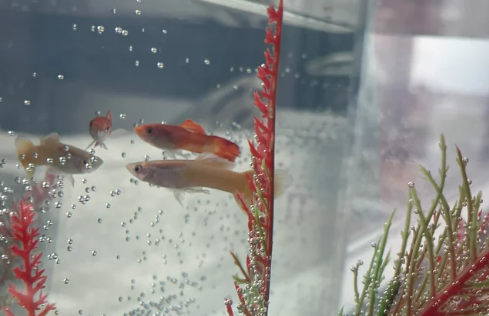
Beginner aquarists often wonder why it matters whether their guppy is male or female. Young guppies are cheap, and people often stock their tanks with guppies, not knowing if they are maintaining the right male-to-female ratio or if this is wise for their tank. Knowing the gender of your guppies helps manage healthy guppies.
1. The Male-to-Female Ratio
Most aquarists know that you should only keep one male guppy to three females to ensure they breed as naturally as possible. If there are too many males, the male guppies will chase the females and this leads to exhaustion in the females.
2. You May Not Want to Breed Your Guppies
When breeding with guppies, you will need a safe space in your tank that acts as a nursery for the young fries when they’re born. If your tank is too small, it wouldn’t be fair to the females to keep having pregnancies only to have the adult fish eat the fries since there’s no space for these young to hide.
3. Breeding Guppies Means More Fish
If your guppies keep breeding because you have males and females mixed, it will soon increase the size of your tank population, placing them under stress as the available space is too little. You will also have to make a plan to accommodate the extra fish or sell them.
Remember that each female will have as many as 30 fries per pregnancy, so if you have two or three females to one male, you could end up with 30-90 fries per breeding session. This could quickly become an astronomical problem.
More fish in a tank strains resources such as oxygen, space, and food. Plus, more fish means more poop, so your tank will quickly become more dirty (much faster), your filters will need more frequent cleaning, and it’s a whole lot of maintenance for you.
4. Responsible Separation
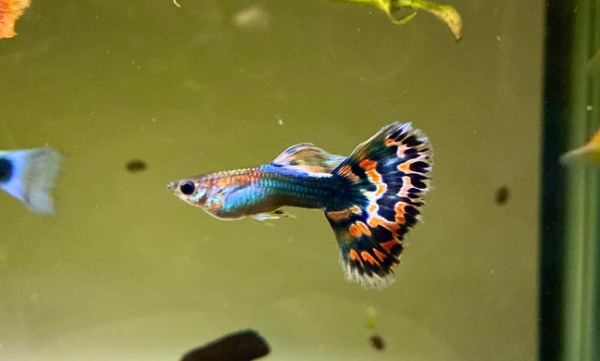
A responsible aquarist knows that it’s better to keep your guppies separated according to their sex. Instead of letting nature do its own thing, remove the male guppy from the tank to allow the females time to spawn their young and also limit the breeding sessions to better times of the year or when you have space for the young.
5. Prevents Interbreeding
If you keep mixed guppy varieties together, it’s best to only have female guppies in one tank and then isolate the breeding pairs when you breed. Like most animals, guppies can also interbreed, resulting in losing some of the prized characteristics in your guppy’s offspring.
Instead, keep the females together and keep the males separated, which means you get to choose what breeding characteristics you’d like to encourage.
6. Manage in-Tank Aggression
If the presence of too many male guppies leads to aggressive behavior, it can lead to severe injuries that will require treatment. Should you breed show guppies, you definitely won’t want your winning guppy to have a chunk of their dorsal fin torn off the day before a big show.
So knowing which guppies are male and which are female will help you manage injuries and ensure your breeding and show guppies are healthy and in perfect condition.
7. Better Breeding Stock
When your guppies are separated according to gender, as soon as their gender-specific characteristics are clear, the guppies will develop bigger and stronger. Your males will stop expending energy to fertilize the females, while the females will not waste energy on early and unplanned pregnancies.
All that extra energy will go into males that grow to optimal size and develop the most beautiful showy tail fins and dorsal fins. The females will also grow larger and be capable of carrying a better-sized batch of fries when pregnant.
Learn about keeping Pearl Gouramis in your aquarium tank.
Gender-Based Guppy Tanks
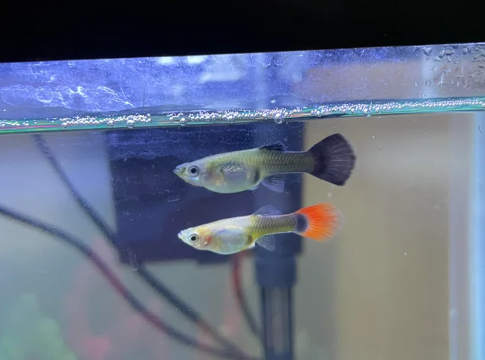
Separate your guppies according to their gender once you notice the male guppies maturing. When their anal fin starts to form pointed hooks, you know the male is mature enough to inseminate the female guppies. It’s at this point that you should separate your guppies.
When the male reaches sexual maturity, their aggression levels will also increase if there are too many other males in the tank or not enough female guppies to go around.
How to Separate Guppies in One Tank
If you can’t access a second tank to house the male or female guppy, use a tank divider to separate them. Tank dividers are available as mesh screens or acrylic panels that attach to the walls of your tank, creating a separate area to keep the guppies apart.
However, with an in-tank division, keeping a low-profile lid on your tank is vital to prevent your guppies from jumping. Guppies are known to jump across tank dividers and even jump from one tank to the tank next to it when it’s breeding time.
If you want a beautiful display fish like the guppy but have a marine tank, consider the Fairy Wrasse.
FAQs
You can keep male and female guppies together in a tank (as long as the ratio of one male guppy to two or three females is followed). More females would possibly lead to the male becoming overexcited and injuring themself with courtship displays.
Adding more males to the tank is not ideal, as the males will defend their little group from other males. Territorial behavior can lead to fighting, injuries, and death.
You can keep male guppies in a single tank, meaning there’s less breeding aggression. You can also keep male and female guppies together, though limiting this to the breeding pair of one male to three females is better.
If you keep male and female guppies in a tank, you should ensure enough space so each guppy pair can enjoy their own space or territory.
In regular courtship, a male guppy shouldn’t nip the female guppy. However, when your tank has too many males in relation to females, and if the space is limited, the male may become territorial. This can result in his courtship display becoming aggressive. So, the male guppy may bite the female in desperation for her to mate with him.
If the tank is too small, keeping male guppies with female guppies usually leads to aggression. So, ensure the guppies have enough space to establish their own territory.
Guppies can be sexed at about one week old when their first gender-specific characteristics appear. With females, their gravid spots will appear, while males may start to form an anal fin.
Surprisingly, the temperature of your breeding tank can influence the gender of your guppy fries. When the water temperature is slightly colder, more female fries mature, while a slightly warmer tank temperature will result in more male guppy fries.
You can use this method to help reduce the number of males born in your guppy’s pregnancies, helping you plan your tank arrangements so you don’t end up with several dozen (or more) males to find space for suddenly.
Final Sexing of Your Guppies
Buying guppies can be a challenge. Not only is it difficult to find the sex of the young and immature guppies, but once they have matured, there’s always a risk your female guppy has stored sperm and can have future pregnancies at any time. So your one guppy female can quickly turn into a breeding machine, even when she has no male guppy near her.
To play it safe, it’s best to sex guppies as soon as their initial gender-specific characteristics start showing. With females, the gravid spot is usually the first to appear, while males may begin to form a more pointed anal fin.
Be responsible and sex your guppies, ensuring you separate the male and female guppies when breeding isn’t an option in your tank setup. When your guppies are not as stressed, they will thrive, and you can enjoy seeing their bright colors dancing in your tank.
If you want to breed your guppies, create a planted carpet to give the fries a space to hide.
